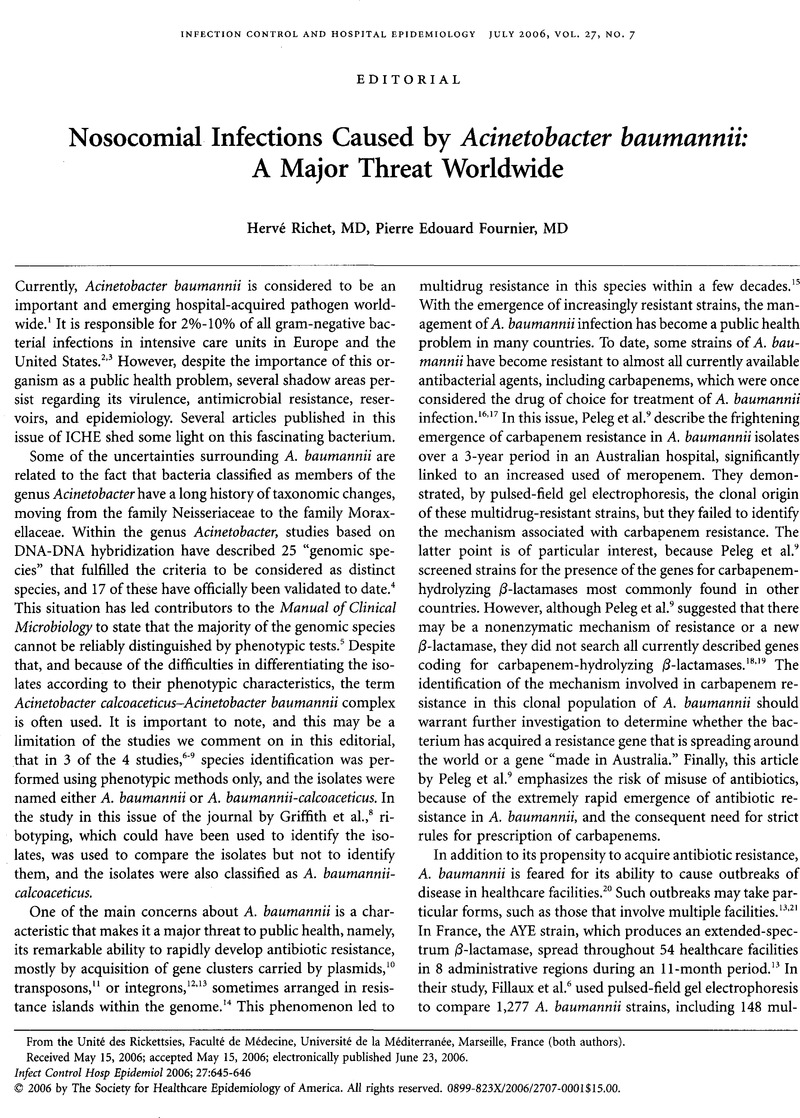Crossref Citations
This article has been cited by the following publications. This list is generated based on data provided by Crossref.
Hujer, Kristine M.
Hujer, Andrea M.
Hulten, Edward A.
Bajaksouzian, Saralee
Adams, Jennifer M.
Donskey, Curtis J.
Ecker, David J.
Massire, Christian
Eshoo, Mark W.
Sampath, Rangarajan
Thomson, Jodi M.
Rather, Philip N.
Craft, David W.
Fishbain, Joel T.
Ewell, Allesa J.
Jacobs, Michael R.
Paterson, David L.
and
Bonomo, Robert A.
2006.
Analysis of Antibiotic Resistance Genes in Multidrug-Resistant
Acinetobacter
sp. Isolates from Military and Civilian Patients Treated at the Walter Reed Army Medical Center
.
Antimicrobial Agents and Chemotherapy,
Vol. 50,
Issue. 12,
p.
4114.
Ohara, Hiroshi
Viet Hung, Nguyen
Anh Thu, Truong
and
Quy, Tran
2007.
Report on Japan-Vietnam collaboration in nosocomial infection control at Bach Mai Hospital, Hanoi from 2000 to 2006.
Tropical Medicine and Health,
Vol. 35,
Issue. 3,
p.
253.
Bradley, John S
Guidos, Robert
Baragona, Steve
Bartlett, John G
Rubinstein, Ethan
Zhanel, George G
Tino, Michael D
Pompliano, David L
Tally, Frank
Tipirneni, Praveen
Tillotson, Glenn S
Powers, John H
and
Tillotson, Glenn S
2007.
Anti-infective research and development—problems, challenges, and solutions.
The Lancet Infectious Diseases,
Vol. 7,
Issue. 1,
p.
68.
Segal, Shana C.
Zaoutis, Theoklis E.
Kagen, Jessica
and
Shah, Samir S.
2007.
Epidemiology of and Risk Factors for Acinetobacter Species Bloodstream Infection in Children.
Pediatric Infectious Disease Journal,
Vol. 26,
Issue. 10,
p.
920.
Rodríguez-Baño, J.
Martí, S.
Soto, S.
Fernández-Cuenca, F.
Cisneros, J.M.
Pachón, J.
Pascual, A.
Martínez-Martínez, L.
McQueary, C.
Actis, L.A.
and
Vila, J.
2008.
Biofilm formation in Acinetobacter baumannii: associated features and clinical implications.
Clinical Microbiology and Infection,
Vol. 14,
Issue. 3,
p.
276.
Gootz, Thomas D
and
Marra, Andrea
2008.
Acinetobacter baumannii:an emerging multidrug-resistant threat.
Expert Review of Anti-infective Therapy,
Vol. 6,
Issue. 3,
p.
309.
Schneiders, Thamarai
Findlay, Jacqueline
and
Amyes, Sebastian G.B.
2008.
Acinetobacter Biology and Pathogenesis.
p.
105.
Whitman, Timothy J.
Qasba, Sonia S.
Timpone, Joseph G.
Babel, Britta S.
Kasper, Matthew R.
English, Judith F.
Sanders, John W.
Hujer, Kristine M.
Hujer, Andrea M.
Endimiani, Andrea
Eshoo, Mark W.
and
Bonomo, Robert A.
2008.
Occupational Transmission ofAcinetobacter baumanniifrom a United States Serviceman Wounded in Iraq to a Health Care Worker.
Clinical Infectious Diseases,
Vol. 47,
Issue. 4,
p.
439.
Russo, Thomas A.
Beanan, Janet M.
Olson, Ruth
MacDonald, Ulrike
Luke, Nicole R.
Gill, Steven R.
and
Campagnari, Anthony A.
2008.
Rat Pneumonia and Soft-Tissue Infection Models for the Study of
Acinetobacter baumannii
Biology
.
Infection and Immunity,
Vol. 76,
Issue. 8,
p.
3577.
Henderson, David K.
2009.
Antimicrobial Drug Resistance.
p.
1295.
Russo, Thomas A.
MacDonald, Ulrike
Beanan, Janet M.
Olson, Ruth
MacDonald, Ian J.
Sauberan, Shauna L.
Luke, Nicole R.
Schultz, L. Wayne
and
Umland, Timothy C.
2009.
Penicillin‐Binding Protein 7/8 Contributes to the Survival ofAcinetobacter baumanniiIn Vitro and In Vivo.
The Journal of Infectious Diseases,
Vol. 199,
Issue. 4,
p.
513.
King, Lauren B.
Swiatlo, Edwin
Swiatlo, Andrea
and
McDaniel, Larry S.
2009.
Serum resistance and biofilm formation in clinical isolates ofAcinetobacter baumannii.
FEMS Immunology & Medical Microbiology,
Vol. 55,
Issue. 3,
p.
414.
Otter, Jonathan A.
Yezli, Saber
Schouten, Marinus A.
van Zanten, Arthur R.H.
Houmes-Zielman, Greetje
and
Nohlmans-Paulssen, Maria K.E.
2010.
Hydrogen peroxide vapor decontamination of an intensive care unit to remove environmental reservoirs of multidrug-resistant gram-negative rods during an outbreak.
American Journal of Infection Control,
Vol. 38,
Issue. 9,
p.
754.
Luke, Nicole R.
Sauberan, Shauna L.
Russo, Thomas A.
Beanan, Janet M.
Olson, Ruth
Loehfelm, Thomas W.
Cox, Andrew D.
St. Michael, Frank
Vinogradov, Evgeny V.
and
Campagnari, Anthony A.
2010.
Identification and Characterization of a Glycosyltransferase Involved in
Acinetobacter baumannii
Lipopolysaccharide Core Biosynthesis
.
Infection and Immunity,
Vol. 78,
Issue. 5,
p.
2017.
Martin, Craig A.
2010.
Management of Antimicrobials in Infectious Diseases.
p.
45.
Eveillard, Matthieu
Soltner, Christophe
Kempf, Marie
Saint-André, Jean-Paul
Lemarié, Carole
Randrianarivelo, Catherine
Seifert, Harald
Wolff, Michel
and
Joly-Guillou, Marie-Laure
2010.
The virulence variability of different Acinetobacter baumannii strains in experimental pneumonia.
Journal of Infection,
Vol. 60,
Issue. 2,
p.
154.
Grisold, A.J.
Zarfel, G.
Strenger, V.
Feierl, G.
Leitner, E.
Masoud, L.
Hoenigl, M.
Raggam, R.B.
Dosch, V.
and
Marth, E.
2010.
Use of automated repetitive-sequence-based PCR for rapid laboratory confirmation of nosocomial outbreaks.
Journal of Infection,
Vol. 60,
Issue. 1,
p.
44.
Russo, Thomas A.
Luke, Nicole R.
Beanan, Janet M.
Olson, Ruth
Sauberan, Shauna L.
MacDonald, Ulrike
Schultz, L. Wayne
Umland, Timothy C.
and
Campagnari, Anthony A.
2010.
The K1 Capsular Polysaccharide of
Acinetobacter baumannii
Strain 307-0294 Is a Major Virulence Factor
.
Infection and Immunity,
Vol. 78,
Issue. 9,
p.
3993.
Nickerson, K. W.
and
Plantz, B.
2010.
Handbook of Hydrocarbon and Lipid Microbiology.
p.
1625.
Hernández-Torres, Alicia
García-Vázquez, Elisa
Gómez, Joaquín
Canteras, Manuel
Ruiz, Joaquín
Fernández-Rufete, Ana
Herreroa, José Antonio
and
Yagüe, Genoveva
2010.
Colonización/infección por Acinetobacter baumannii multirresistente y resistente a carbapenémicos: epidemiología y factores predictivos de infección.
Medicina Clínica,
Vol. 135,
Issue. 9,
p.
389.



